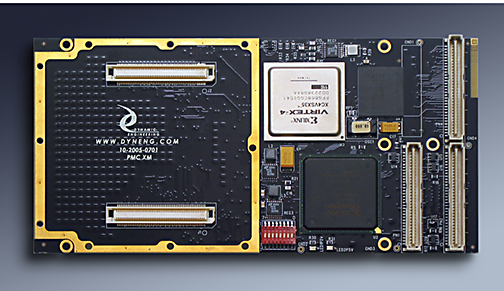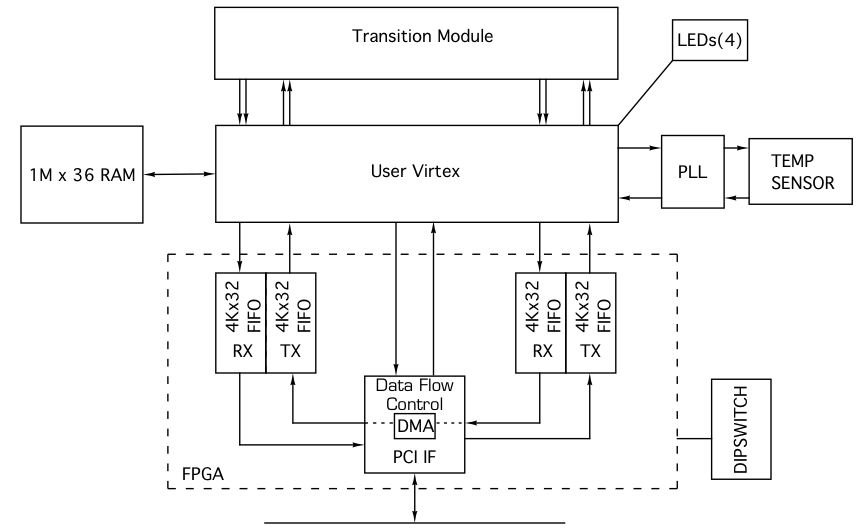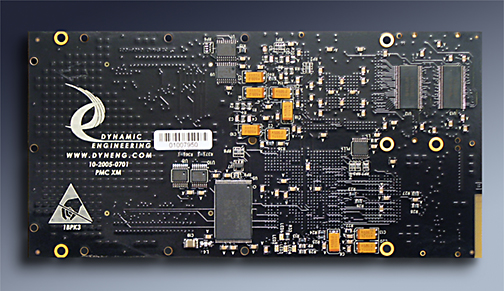








PMC-XM
PMC Compatible Reprogrammable Logic with Transition Module "XM"






















| Standard Single PMC |
|
| |
|
| 13 bit, one degree C I2C interface temperature sensor can be read for a local temperature. Attached to Virtex device. |
|
| 1M x 36 QDR SRAM provided attached to Virtex. Additional internal Block RAM used for FIFO´s to support DMA transfers. |
|
| Two programmable PLL reference clocks are provided for the Virtex. A reference oscillator is provided. The standard frequency is 40 MHz. Other frequencies are available by request. A 2X copy of the PCI clock is used for the inter-FPGA bus. The 66 MHz can be used as a reference. |
|
| Location for transition module provided to allow for user defined IO. The position has an exposed ground plane for EMI, filtered power and ground references, and 81 connections between the Virtex and the Transition Module. |
|
| |
|
| 4 LED´s controlled by the Virtex are provided. The LED´s can be used for development or user applications. The LED´s are located on the rear to be visible when installed. |
|
| |
|
| Standard 33 MHz. operation |
|
| Standard 32 bit operation supported. |
|
| PMC registers are read-writeable. Base driver has support for reference design registers within Virtex and a "generic" capability to communicate with user defined registers and memory. | |
| Status can be polled for non-interrupt driven operation. User defined interrupts supported. |
|
| |
|
| +5 only. 3.3V, 2.5V, 1.8V, 1.2V converted with on-board regulators. |
|
| An 8 position switch is attached to the base FPGA to allow for configuration control, addressing multiple cards, or to facilitate debugging |
|
| |
|
| Speed | PMC XM is optimized for IO interfacing requirements. The FIFO memories and programmable interrupts off-load the CPU from most of the management. Independent DMA channels further reduce CPU overhead when multiple streams are in use. The FIFO access is optimized for the PCI bus further reducing overhead by speeding up the data transfer. On the IO side, PMC XM has independent and interconnected channel functions. |
| |
|
| PMC-XM is available off-the-shelf at a reasonable price. Custom versions can also be arranged. PMC-XM is easily programmed to implement new functions. Previously implemented "custom designs" are available without the costs of schematic level design, layout, debugging etc. A modified PMC-XM will represent a large cost and time savings in your budget. |
|
| |
|
| PMC-XM is easy to use. Point and shoot - just fill the FIFO and set the start bit to get your custom protocol transmitting. Built in loop-back capabilities and engineering kits help with integration into your system. Windows driver available. |
|
| |
|
| Dynamic Engineering works to keep the PMC-XM in stock. Send in your order and in most cases have your hardware the next day. With a custom design a 1-2 week design period is usually required. We can support immediately with the std version then the FLASH later to help get your project going - or you can do the design yourself and start now. The manuals are located at the bottom of this page. |
|
| |
|
| PMC-XM is a standard single width PMC card and meets the PMC mechanical specifications. PMC-XM can be used in all PMC slots. |
|
| |
|
| PMC XM is PMC compliant per the IEEE 1386 specification. | |
| |
|
| PMC-XM is PCI compliant. You can develop with a PCI to PMC adapter - PCI2PMC or PCIBPMC. |










